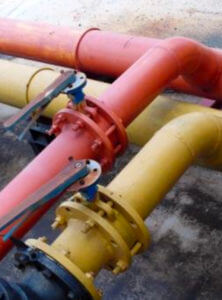Plumbing is one of the areas of home improvement that drives DIY enthusiasts crazy. Problems can arise with the plumbing which makes the project bigger and increases the frustration that people feel. This is a problem that even the professionals have to face. Fortunately, there are ways to manage these frustrations and this is through the use of tips and tricks from the experts.
What To Do When You Can’t Cut A Pipe
If you have a soldered pipe that you need to disconnect, the best solution is to cut it. The problem is that there are times when you are unable to cut the pipe due to space limitations or the remaining pipe will be too short for new connections. The solution to this problem is to reheat the joint and pull off the fittings as the solder melts.
When you do this, you need to have a wet rag handy to wipe off the solder as it melts. This will ensure that it does not harden before you can remove it. It is important that you wear gloves while doing this to prevent burns to your hands. There are times when a single wipe will have the pipe ready for the new connection, but you are more likely to have to scour the excess solder off. This can be done with an emery cloth or sandpaper.
Use Plastic Drain Lines
A lot of people assume that metal drain lines in Elwood will be better than plastic. While they do appear to be more reliable than their plastic counterparts, the plastic lines are actually better in many ways. It is important that you know what some of the benefits of plastic drain lines are before you decide that metal is the best option.
Plastic drain lines are cheaper to purchase which is something that many DIY home improvers are looking for. Plastic lines are also easier to install as well as adjust when there is a leak. Additionally, these pipes will not corrode like their metal counterparts.

How To Loosen Stubborn Pipes and plumbing
Loosening trodden connections is not always as easy as it might seem. There are times when the connection will not budge and this can lead to a lot of frustration. The best solution in these cases is to apply some heat. Applying heat often works on older connections which were sealed with pipe dope which will harden over time.
When you apply heat, you need to be patient. It will take a few minutes to heat up the metal to the right temperature. While doing this, it is important that you protect the surrounding surfaces with a flame-resistant cloth. Once the pipe is hot enough, you should be able to disconnect it. This method of removing threaded connections should only be used on waste and water pipes, never use it on fuel or gas lines.
Piggyback Stubborn Shutoffs
Anyone interested in home improvements will know that the shut-off valves in the toilet and under the sink do not have a good reliability record. There are times when they will not close completely and other times when they will simply not close at all. Most people will look at replacing the valve at this point, but there is an alternative.
Most home improvement centers will often carry a piggyback shut-off valve. This valve will connect to the existing valve. You will need to disconnect the supply line and install the new piggyback valve. If your old valve closes most of the way, you do not have to turn off the water as a container under the valve will catch the trickle of water while you work.
Do Not Tighten Supply Lines Too Much
A lot of people are tempted to tighten their supply lines as much as possible to be on the safe side. The problem is that tightening the supply line too much is as dangerous as tightening it too little. A loose connection that leaks can easily be tightened, but a connection that is too tight will damage the runner seals. The threaded nuts will also be damaged and could crack when they are tightened too much.
The best habit to have for tightening supply lines is to make them finger-tight. You will then need to give them an eighth or quarter turn with pliers. If the line leaks, you can tighten them a bit more.
Do Not Reuse Supply Lines
If you are looking to save some money when replacing a faucet or toilet, you might want to reuse old supply lines. This is something that you should actually avoid because the plastic will degrade over time. A small leak in the flexible supply line can cause major water damage and you will want to avoid this.
The risk of leaks is small, but it is not a risk that you want to take. It is recommended that you buy new supply lines which have been covered in braided stainless steel. These lines are less likely to burst and if you already have braided lines, you should replace them.
How To Use Thread Tape
Thread tape is also known as plumber’s tape is something that a lot of people use, but some people do not know how to use correctly. When you use thread tape, you should look at getting the thicker tape which is generally pink for water and yellow for gas. While the cheaper and thinner tape will work, the thicker one is easier to handle and will tear neatly, especially in Elwood
You should never use thread tape for any connection that is not threaded. Plumbing dope should be used for compression and other connections. Thread tape will not seal the pipes when they have other connections.
There are no rules to how many times you should wrap the tape around the pipe. However, plumbers will generally wrap the pipe 3 times with the tape. This ensures that there is enough tape on the pipe so it will not tear when the connection is placed over it.
~ The Elwood Plumbers Team

